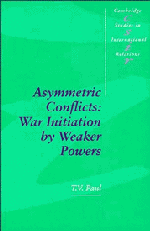Book contents
2 - Explaining war initiation by weaker powers in asymmetric conflicts
Published online by Cambridge University Press: 03 May 2011
Summary
Introduction
The preceding chapter raises the point that the question of relatively weak states initiating wars has received insufficient attention in international relations theory and conflict analysis. Although some theories touch on asymmetric wars, they consider in detail neither the factors and conditions that generate them, nor the process through which this type of war initiation occurs compared to other forms of dyadic or general wars. Therefore, the need to explain and connect key variables that can have a causal effect on the decision to initiate war is all the more imperative. To begin with, I accept the notion that there are profound and general causes for the outbreak of wars, such as conflicts resulting from the anarchic and self help nature of the international system. These general causes, however, can be elucidated as well as complemented if we can trace the proximate or more immediate causes that recur from case to case in a particular type of war. A simple analogy might help clarify this point. There is a constant possibility of fire breaking out in many forests. But, like wars, wildfires do not necessarily break out all the time. What ignites fire at a given point in time may depend on several factors and conditions, such as the temperature level and the direction of the wind.
- Type
- Chapter
- Information
- Asymmetric ConflictsWar Initiation by Weaker Powers, pp. 15 - 38Publisher: Cambridge University PressPrint publication year: 1994
- 1
- Cited by



